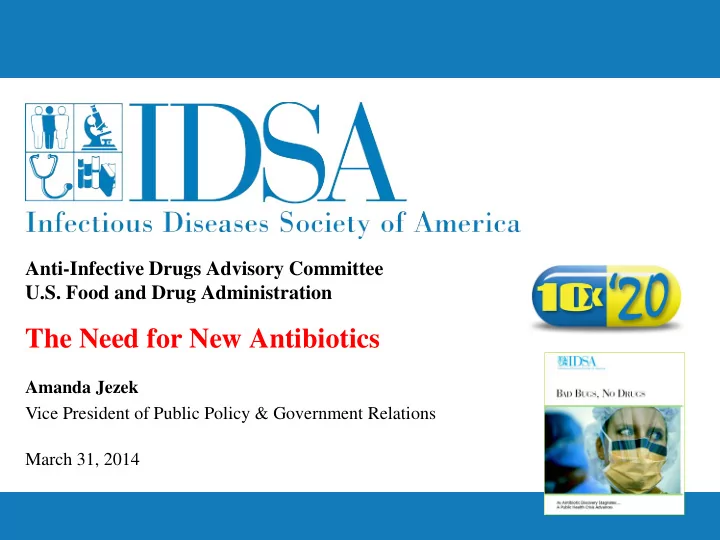

Anti-Infective Drugs Advisory Committee U.S. Food and Drug Administration The Need for New Antibiotics Amanda Jezek Vice President of Public Policy & Government Relations March 31, 2014
IDSA Membership Administration Primary Professional Activity 7% 2% 5% Basic Research 4% Clinical 3% 10,000+ strong 8% Microbiology Clinical Research Majority physicians 14% Hospital providing clinical care Epidemiology Patient Care 54% 3% Public Hlth 2
IDSA’s Motivation/Perspective Our patients need new antibiotics to survive! • Unlike other disease areas (cancer, HIV/AIDS, etc.), there are no easily identifiable patient advocacy groups to push for change and to put a human face on the antibiotic resistance problem • IDSA decided it must step in to advocate on our patients’ behalf • We have not taken any pharmaceutical funding to support these advocacy efforts • IDSA does not take a position on the potential FDA approval of any specific product. 3
Physician Perspective: Why Patients Need New Antibiotics Now Premature Death Life-altering Disability Mariana Bridi da Costa Rebecca Lohsen (22 yr)--Dead Tom Dukes: colostomy, lost 8” colon (17 yr)--Dead Carlos Don Ricky Lannetti Addie Rereich, 11yo (12 yr)--Dead (21 yr)--Dead Double lung transplant Stroke, nearly blind $6 million hospital bill www.AntibioticsNow.org 4
Declining New Antibacterial Drug Approvals, U.S. Approvals Spellberg, CID 2004, Modified
IDSA’s 2004 Report on AR “Bad Bugs, No Drugs: As Antibiotic Discovery Stagnates, A Public Health Crisis Brews” 6
Bad Bugs, No Drugs: No ESKAPE 2009 IDSA Update • Growing resistance among gram-positive and gram-negative pathogens that cause infection in the hospital and in the community • “ESKAPE” pathogens Enterococcus faecium , Staphylococcus aureus, Klebsiella pneumoniae, Acinetobacter baumanii, Pseudomonas aeruginosa , and Enterobacter species) • ESKAPE pathogens cause the majority of US hospital infections and effectively “escape” the effects of antibacterial drugs • Antibiotic pipeline remains unacceptably lean
The 10 x ‘20 Initiative • Global commitment to develop 10 new systemic antibacterial drugs by 2020 (CID; April 2010) • Bring together essential leaders: global political, scientific, industrial, economic, intellectual property, policy, medical and philanthropic leaders to determine the right combination of incentives necessary to establish a sustainable R&D enterprise 8
State of Antibiotic R&D Remains Dire April 2013 analysis by IDSA: • Only seven new drugs in development for the treatment of infections caused by multidrug-resistant Gram-negative bacilli (GNB) bacteria. • There is no guarantee that any of these will make it across the finish line to FDA approval • None of them will work against the pan-resistant pathogens (those resistant to all current antibiotics) Boucher et al. Clinical Infectious Diseases 2013 9
Status of the 10 x ‘20 Initiative 10
Antibiotic Resistance Threats Grow Centers for Disease Control and Prevention (CDC) Report Conservative estimates indicate that over 2 million Americans are sickened every year by antibiotic resistant infections and at least 23,000 die . The actual numbers are likely far higher. 11
Carbapanem-Resistant Enterbacteriaceae • One example of an “urgent threat” according to CDC. • 9,000 drug resistant infections per year. • 600 deaths per year. • CRE bacteria have become resistant to all or nearly all currently available antibiotics . • CDC laboratories have confirmed at least one type of CRE in healthcare facilities in 44 states. • About 4% of U.S. short-stay hospitals had at least one patient with a serious CRE infection during the first half of 2012. About 18% of long-term acute care hospitals had one. • Up to half of all bloodstream infections caused by CRE result in death. 12
Antibiotic-Resistant Bacteria: Economic Burden Antibiotic resistant bacterial infections result in: • Additional $21-34 billion cost annually to US healthcare system • Additional 8 million hospital days RR Roberts, CID 2009:49, 1175-1184; 13 PD Maudlin, AAC 2010:54, 109-115
Antibiotic Resistance: Realities for Patients and Physicians • The only antibiotic remaining to treat many Gram negative bacterial infections is Colistin. • Colistin is toxic; it causes kidney failure; its efficacy is questionable. • Colistin had not been used in 30 years, but has been pulled off the shelves because there is nothing else. • Gram negative bacteria are now developing resistance to Colistin. • Soon there will be no alternatives for these patients. Current alternatives for these patients: “Do you want to die, or to be on dialysis for the rest of your life or until you can get a kidney transplant?” 14
IDSA’s Goal: New Antibiotics to Save Lives Prior generations gave us the gift of antibiotics. Today, we have a moral obligation to ensure this global treasure is available for our children and future generations. 15
Recommend
More recommend